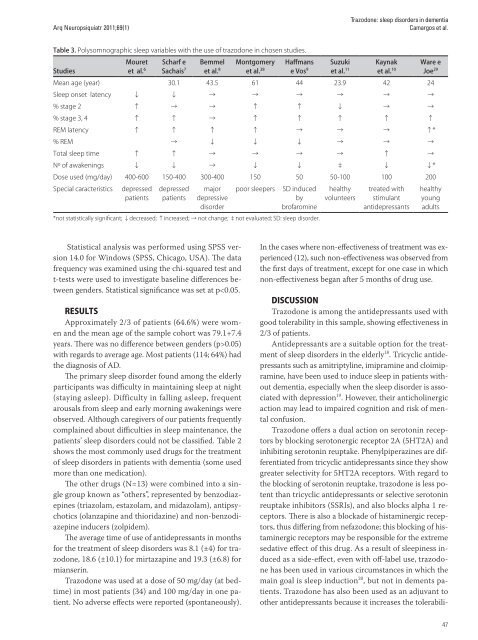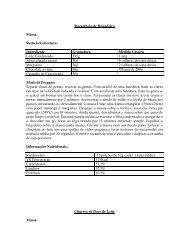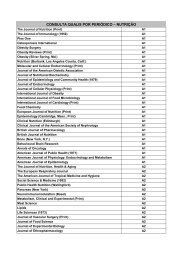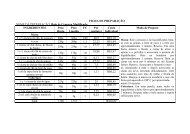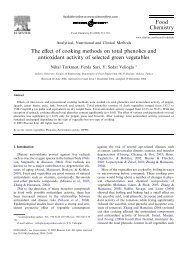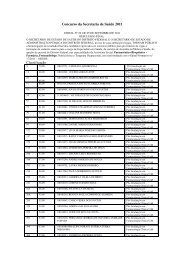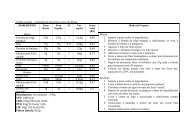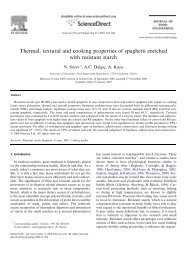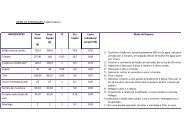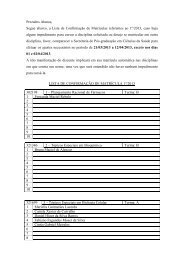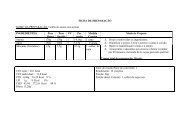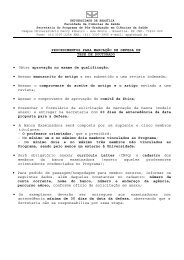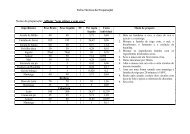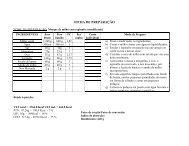Trazodone for the treatment of sleep disorders in dementia - UnB
Trazodone for the treatment of sleep disorders in dementia - UnB
Trazodone for the treatment of sleep disorders in dementia - UnB
You also want an ePaper? Increase the reach of your titles
YUMPU automatically turns print PDFs into web optimized ePapers that Google loves.
Arq Neuropsiquiatr 2011;69(1)<br />
<strong>Trazodone</strong>: <strong>sleep</strong> <strong>disorders</strong> <strong>in</strong> <strong>dementia</strong><br />
Camargos et al.<br />
Table 3. Polysomnographic <strong>sleep</strong> variables with <strong>the</strong> use <strong>of</strong> trazodone <strong>in</strong> chosen studies.<br />
Studies<br />
Mouret<br />
et al. 6<br />
Scharf e<br />
Sachais 7<br />
Bemmel<br />
et al. 8<br />
Montgomery<br />
et al. 28<br />
Haffmans<br />
e Vos 9<br />
Suzuki<br />
et al. 11<br />
Kaynak<br />
et al. 10<br />
Mean age (year) 30.1 43.5 61 44 23.9 42 24<br />
Sleep onset latency ↓ ↓ → → → → → →<br />
% stage 2 ↑ → → ↑ ↑ ↓ → →<br />
% stage 3, 4 ↑ ↑ → ↑ ↑ ↑ ↑ ↑<br />
REM latency ↑ ↑ ↑ ↑ → → → ↑*<br />
% REM → ↓ ↓ ↓ → → →<br />
Total <strong>sleep</strong> time ↑ ↑ → → → → ↑ →<br />
Nº <strong>of</strong> awaken<strong>in</strong>gs ↓ ↓ → ↓ ↓ ‡ ↓ ↓*<br />
Dose used (mg/day) 400-600 150-400 300-400 150 50 50-100 100 200<br />
Special caracteristics<br />
depressed<br />
patients<br />
depressed<br />
patients<br />
major<br />
depressive<br />
disorder<br />
poor <strong>sleep</strong>ers<br />
SD <strong>in</strong>duced<br />
by<br />
br<strong>of</strong>arom<strong>in</strong>e<br />
*not statistically significant; ↓decreased; ↑<strong>in</strong>creased; → not change; ‡not evaluated; SD: <strong>sleep</strong> disorder.<br />
healthy<br />
volunteers<br />
treated with<br />
stimulant<br />
antidepressants<br />
Ware e<br />
Joe 29<br />
healthy<br />
young<br />
adults<br />
Statistical analysis was per<strong>for</strong>med us<strong>in</strong>g SPSS version<br />
14.0 <strong>for</strong> W<strong>in</strong>dows (SPSS, Chicago, USA). The data<br />
frequency was exam<strong>in</strong>ed us<strong>in</strong>g <strong>the</strong> chi-squared test and<br />
t-tests were used to <strong>in</strong>vestigate basel<strong>in</strong>e differences between<br />
genders. Statistical significance was set at p0.05)<br />
with regards to average age. Most patients (114; 64%) had<br />
<strong>the</strong> diagnosis <strong>of</strong> AD.<br />
The primary <strong>sleep</strong> disorder found among <strong>the</strong> elderly<br />
participants was difficulty <strong>in</strong> ma<strong>in</strong>ta<strong>in</strong><strong>in</strong>g <strong>sleep</strong> at night<br />
(stay<strong>in</strong>g a<strong>sleep</strong>). Difficulty <strong>in</strong> fall<strong>in</strong>g a<strong>sleep</strong>, frequent<br />
arousals from <strong>sleep</strong> and early morn<strong>in</strong>g awaken<strong>in</strong>gs were<br />
observed. Although caregivers <strong>of</strong> our patients frequently<br />
compla<strong>in</strong>ed about difficulties <strong>in</strong> <strong>sleep</strong> ma<strong>in</strong>tenance, <strong>the</strong><br />
patients’ <strong>sleep</strong> <strong>disorders</strong> could not be classified. Table 2<br />
shows <strong>the</strong> most commonly used drugs <strong>for</strong> <strong>the</strong> <strong>treatment</strong><br />
<strong>of</strong> <strong>sleep</strong> <strong>disorders</strong> <strong>in</strong> patients with <strong>dementia</strong> (some used<br />
more than one medication).<br />
The o<strong>the</strong>r drugs (N=13) were comb<strong>in</strong>ed <strong>in</strong>to a s<strong>in</strong>gle<br />
group known as “o<strong>the</strong>rs”, represented by benzodiazep<strong>in</strong>es<br />
(triazolam, estazolam, and midazolam), antipsychotics<br />
(olanzap<strong>in</strong>e and thioridaz<strong>in</strong>e) and non-benzodiazep<strong>in</strong>e<br />
<strong>in</strong>ducers (zolpidem).<br />
The average time <strong>of</strong> use <strong>of</strong> antidepressants <strong>in</strong> months<br />
<strong>for</strong> <strong>the</strong> <strong>treatment</strong> <strong>of</strong> <strong>sleep</strong> <strong>disorders</strong> was 8.1 (±4) <strong>for</strong> trazodone,<br />
18.6 (±10.1) <strong>for</strong> mirtazap<strong>in</strong>e and 19.3 (±6.8) <strong>for</strong><br />
mianser<strong>in</strong>.<br />
<strong>Trazodone</strong> was used at a dose <strong>of</strong> 50 mg/day (at bedtime)<br />
<strong>in</strong> most patients (34) and 100 mg/day <strong>in</strong> one patient.<br />
No adverse effects were reported (spontaneously).<br />
In <strong>the</strong> cases where non-effectiveness <strong>of</strong> <strong>treatment</strong> was experienced<br />
(12), such non-effectiveness was observed from<br />
<strong>the</strong> first days <strong>of</strong> <strong>treatment</strong>, except <strong>for</strong> one case <strong>in</strong> which<br />
non-effectiveness began after 5 months <strong>of</strong> drug use.<br />
DISCUSSION<br />
<strong>Trazodone</strong> is among <strong>the</strong> antidepressants used with<br />
good tolerability <strong>in</strong> this sample, show<strong>in</strong>g effectiveness <strong>in</strong><br />
2/3 <strong>of</strong> patients.<br />
Antidepressants are a suitable option <strong>for</strong> <strong>the</strong> <strong>treatment</strong><br />
<strong>of</strong> <strong>sleep</strong> <strong>disorders</strong> <strong>in</strong> <strong>the</strong> elderly 18 . Tricyclic antidepressants<br />
such as amitriptyl<strong>in</strong>e, imipram<strong>in</strong>e and cloimipram<strong>in</strong>e,<br />
have been used to <strong>in</strong>duce <strong>sleep</strong> <strong>in</strong> patients without<br />
<strong>dementia</strong>, especially when <strong>the</strong> <strong>sleep</strong> disorder is associated<br />
with depression 19 . However, <strong>the</strong>ir antichol<strong>in</strong>ergic<br />
action may lead to impaired cognition and risk <strong>of</strong> mental<br />
confusion.<br />
<strong>Trazodone</strong> <strong>of</strong>fers a dual action on seroton<strong>in</strong> receptors<br />
by block<strong>in</strong>g serotonergic receptor 2A (5HT2A) and<br />
<strong>in</strong>hibit<strong>in</strong>g seroton<strong>in</strong> reuptake. Phenylpiperaz<strong>in</strong>es are differentiated<br />
from tricyclic antidepressants s<strong>in</strong>ce <strong>the</strong>y show<br />
greater selectivity <strong>for</strong> 5HT2A receptors. With regard to<br />
<strong>the</strong> block<strong>in</strong>g <strong>of</strong> seroton<strong>in</strong> reuptake, trazodone is less potent<br />
than tricyclic antidepressants or selective seroton<strong>in</strong><br />
reuptake <strong>in</strong>hibitors (SSRIs), and also blocks alpha 1 receptors.<br />
There is also a blockade <strong>of</strong> histam<strong>in</strong>ergic receptors,<br />
thus differ<strong>in</strong>g from nefazodone; this block<strong>in</strong>g <strong>of</strong> histam<strong>in</strong>ergic<br />
receptors may be responsible <strong>for</strong> <strong>the</strong> extreme<br />
sedative effect <strong>of</strong> this drug. As a result <strong>of</strong> <strong>sleep</strong><strong>in</strong>ess <strong>in</strong>duced<br />
as a side-effect, even with <strong>of</strong>f-label use, trazodone<br />
has been used <strong>in</strong> various circumstances <strong>in</strong> which <strong>the</strong><br />
ma<strong>in</strong> goal is <strong>sleep</strong> <strong>in</strong>duction 20 , but not <strong>in</strong> dements patients.<br />
<strong>Trazodone</strong> has also been used as an adjuvant to<br />
o<strong>the</strong>r antidepressants because it <strong>in</strong>creases <strong>the</strong> tolerabili-<br />
47


